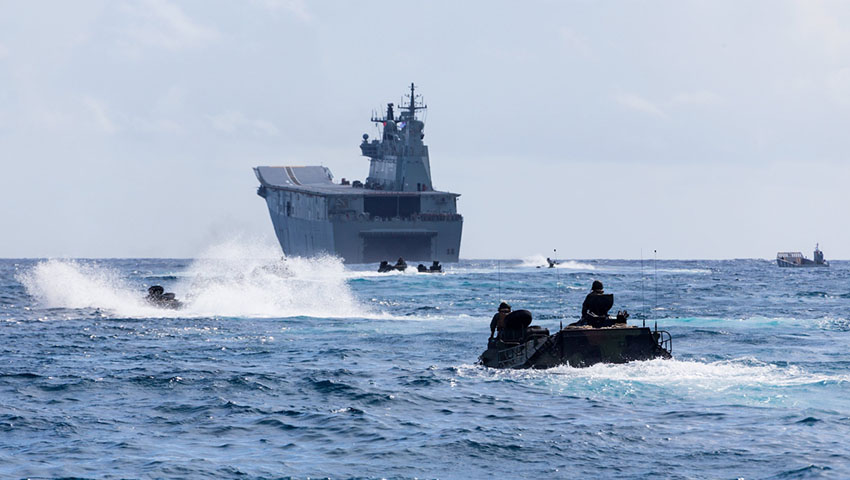The rise of Indo-Pacific Asia is presenting a challenge to “business as usual” for Australia’s defence planners, calling into question the history of Australia’s strategic doctrine to inform its future strategic capabilities and policy.
To continue reading the rest of this article, please log in.
Create free account to get unlimited news articles and more!
Australia’s strategic and defence planning has historically been defined by several different, yet interconnected and increasingly complex factors, namely:
- The benevolence and continuing stability of its primary strategic partner;
- The geographic isolation of the continent, highlighted by the ‘tyranny of distance’;
- A relatively small population in comparison with our neighbours; and
- Increasingly, the geo-political, economic and strategic ambition and capabilities of Australia’s Indo-Pacific Asian neighbours.
Accordingly, as the international and regional power paradigms have evolved throughout history, so too have Australia’s strategic priorities and capabilities.
Australia’s earliest strategic relationship with the British Empire established the foundation for all future defence and national security relationships both within Indo-Pacific Asia and the wider world.
As British power slowly declined following the First World War – and in the face of a seemingly unstoppable advance by Imperial Japan culminating in the fall of Singapore, placing Australia under direct threat – the nation not only turned its attention to a new strategic benefactor in the US, but also laid the foundations for a post-war period of sovereign defence capabilities.
Following the defeat of Japan in the Pacific, Australia embraced the role of ‘loyal deputy’ to the post-Second World War order the US set about to establish, bringing the nation into direct conflict with communism throughout south-east Asia.
Recently, this role has expanded to include the nation’s response to Islamic extremism, with its support of US-led interventions in both Afghanistan and Iraq further cementing the nation’s position as an invaluable global ally to the US and a critical Indo-Pacific nation invested in the economic and strategic stability of Indo-Pacific Asia.
Today, however, this post-World War Two economic, political and strategic order is being challenged as a result of increased competition between the US and the rising superpower, China.
Australia’s strategic calculations have also been influenced by traditional powers like Japan and, critically, the region’s developing powers including India, Indonesia, Vietnam, Thailand and the Philippines in the economic and strategic stability of Indo-Pacific Asia.
Traditional state-based actors are not the only factors serving to dramatically challenge the post-war order. The rise of non-state actors, ranging from transnational criminal organisations to religious extremism including Jemaah Islamiyah, Abu Sayyaf and Islamic State’s affiliates that have rapidly dissolved the nation’s traditional isolation and insulation from direct threat.
Recognising this, both sides of Australian politics have since the mid-2000s sought to engage differently with Indo-Pacific Asia at both a diplomatic and defence level, ranging from school exchange programs in the New Columbo Plan and the ‘Pacific step-up’ program to the annual Indo-Pacific Endeavour military exercises.
Despite this, the Commonwealth government has embarked on the largest peacetime build-up of the nation’s military capabilities, with $200 billion slated to be invested into the Australian Defence Force to deliver leading-edge military capabilities.
Industry development has played a key role in supporting this program of defence capability development, with a dual focus on supporting both the domestic requirements of the ADF while seeking to export locally developed and manufactured defence equipment to increased economic benefit.
Australia has also invested heavily in its strategic relationships with key regional and global allies, including the UK, France and the US, as a means of reassuring the nation that if trouble were to occur, the nation’s big and burly global protectors wouldn’t be too far away.
While relationships with global great powers play an important role in the nation’s diplomatic and strategic arsenal, Australia has sought to reaffirm and enhance partnerships with nations like Japan, South Korea and Singapore, all nations with vested interests in maintaining the regional status-quo.
While each of these individual factors play a critical role in influencing the way Australia engages with Indo-Pacific Asia at both a diplomatic and strategic level, Australia’s policy makers have a role to play in guiding and directing the nation’s role in the region.
Australia’s history of strong and respected engagement in Indo-Pacific Asia establishes a promising precedent for enhanced engagement with the nation’s regional neighbours. However, it is important to inform the nation’s future direction based on the success and failures of its past doctrines and policies in similar times.
More to come
This serves as an introduction to a multi-part analysis series. Part two will review and analyse Australia’s post-Second World War defence policies and doctrine, Forward Defence, covering the Konfrontasi, Korea and Vietnam, and the lessons learned and failures of the doctrine.
Part three will review and analyse the post-Vietnam era of Defence of Australia and the Dibb review of 1987 until Australia’s engagement in the first Gulf War, East Timor and into the new millennium.
Part four will take a closer look at the emerging capabilities of Indo-Pacific Asia's leading economic, political and strategic powers, China and India, while part five will provide similar insight into the capabilities transforming the strategic capacity of the regions emerging middle and great powers, mainly Thailand, Vietnam, and Indonesia.
Finally, part six, in collaboration with leading strategic policy experts, will seek to inform future defence and strategic planning with a focus on strengthening the force structure and capabilities of the Australian Defence Force in the mid-to-late 21st century.

 Login
Login







